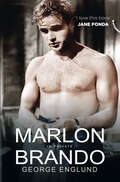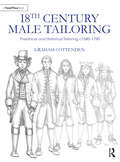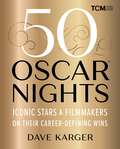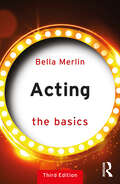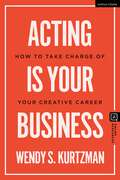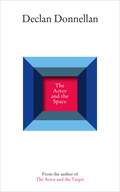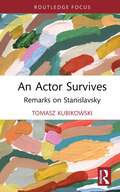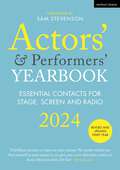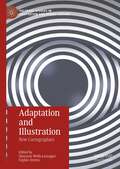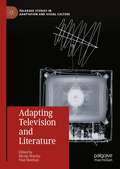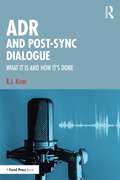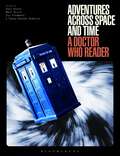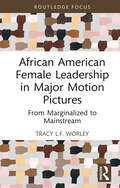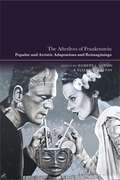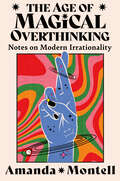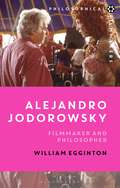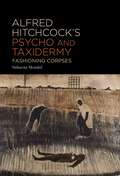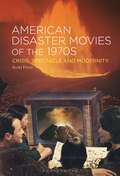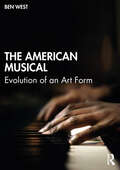- Table View
- List View
Marlon Brando in Private - 'I love this book' Jane Fonda
by George Englund'Riveting' Kirk Douglas From his first Oscar, Marlon Brando built an impenetrable fortress around his private life: unauthorised releases—or snapshots of him, even by friends—were forbidden. George Englund was Brando's closest friend for almost fifty years and the last person to visit him before his death. Based on deeply personal stories from the death of their sons to Jackie Kennedy and Marilyn Monroe, he draws Brando's life as only they knew it. A young actor emerges who was beautiful in every way; driven by his instinctive talent to break new ground, athletic, muscular, seductive, intelligent and generous. And, from early on, seeds of self-destruction began to grow.
18th Century Male Tailoring: Theatrical and Historical Tailoring c1680 – 1790
by Graham Cottenden18th Century Male Tailoring: Theatrical and Historical Tailoring c1680 – 1790 introduces the reader to English eighteenth-century tailoring and covers the drafting of patterns, cutting out in cloth and construction techniques in sequence for the tailoring of waistcoats, breeches and coats. From choosing the right cloth to preparing for the fitting process, this how-to guide will help readers create beautiful, historically accurate eighteenth-century male garments for events and performances. The book contains the following: step-by-step instructions complete with illustrations for students and costumiers who are new to the making of male tailored garments from the eighteenth century; drafting blocks and construction techniques for the different styles through the eighteenth century and patterns, photographs, detailed measurements and articles taken from a variety of male coats, waistcoats and trousers from c1680 – c1790 from museums and collections. 18th Century Male Tailoring is written for costume design and construction students, fashion students and practitioners who have a reasonable working knowledge of sewing and general costume making, but not necessarily of tailoring, drafting patterns, cutting skills and the making of male garments.
18th Century Male Tailoring: Theatrical and Historical Tailoring c1680 – 1790
by Graham Cottenden18th Century Male Tailoring: Theatrical and Historical Tailoring c1680 – 1790 introduces the reader to English eighteenth-century tailoring and covers the drafting of patterns, cutting out in cloth and construction techniques in sequence for the tailoring of waistcoats, breeches and coats. From choosing the right cloth to preparing for the fitting process, this how-to guide will help readers create beautiful, historically accurate eighteenth-century male garments for events and performances. The book contains the following: step-by-step instructions complete with illustrations for students and costumiers who are new to the making of male tailored garments from the eighteenth century; drafting blocks and construction techniques for the different styles through the eighteenth century and patterns, photographs, detailed measurements and articles taken from a variety of male coats, waistcoats and trousers from c1680 – c1790 from museums and collections. 18th Century Male Tailoring is written for costume design and construction students, fashion students and practitioners who have a reasonable working knowledge of sewing and general costume making, but not necessarily of tailoring, drafting patterns, cutting skills and the making of male garments.
50 Oscar Nights: Iconic Stars & Filmmakers on Their Career-Defining Wins
by Dave KargerAn exclusive look behind the scenes of the Academy Awards as top stars and filmmakers discuss their Oscar wins and tell never-before-told tales of Hollywood's biggest night, in a collection of original interviews with Turner Classic Movies host and entertainment media journalist Dave Karger. For almost a century, movie fans have been riveted by the Academy Awards and the stars who have won Oscars. 50 Oscar Nights takes readers behind the scenes of Hollywood&’s most storied awards show through new and exclusive interviews with dozens of A-list actors, filmmakers, and craftspeople spanning sixty years of the Oscars. Here these artists reflect on their winning work and recount all the details of how they got ready, how they felt when they heard their name and got up on stage to accept their award, what they wore, how the entire experience impacted their life, and more. Some interviews bring to light fun stories like why Hilary Swank decided to celebrate her Academy Award at the Astro Burger in West Hollywood, or insight into the work as Elton John explains why he was convinced he won his Best Original Song award for the wrong tune. Other interviews illuminate why for some honorees, such as Julia Roberts, John Legend, and Octavia Spencer, the day remains a life highlight to be treasured, while for Marlee Matlin, Mira Sorvino, and Barry Jenkins, complex emotions cloud what most think would be a purely celebratory moment. Filled with more than 150 photos of red-carpet moments, emotional acceptances, and after-party play, 50 Oscar Nights is both a stunning record of cinema glamour and a must-read for any movie lover. Full list of interviewees: Nicole Kidman, Elton John, Jennifer Hudson, Steven Spielberg, Jane Fonda, Barry Jenkins, Halle Berry, J. K. Simmons, Julia Roberts, John Legend, Rita Moreno, Martin Scorsese, Marlee Matlin, Dustin Hoffman, Hannah Beachler, Cameron Crowe, Mira Sorvino, Kevin O&’Connell, Sally Field, Kristen Anderson-Lopez and Robert Lopez, Eddie Redmayne, Lee Grant, Louis Gossett Jr., Hilary Swank, Clint Eastwood, Jessica Yu, Michael Douglas, Catherine Martin, Francis Ford Coppola, Allison Janney, Mel Brooks, Emma Thompson, Peter Jackson, Marcia Gay Harden, Mark Bridges, Sofia Coppola, Joel Grey, Glen Hansard and Markéta Irglová, Olivia Colman, Rob Epstein, Whoopi Goldberg, Alan Menken, Melissa Etheridge, Sissy Spacek, Keith Carradine, Estelle Parsons, Geoffrey Fletcher, Octavia Spencer, Aaron Sorkin, Meryl Streep
Acting: The Basics (The Basics)
by Bella MerlinActing: The Basics 3rd Edition is a dynamic response to recent societal and entertainment industry changes, focusing on inclusion, diversity and equity, and the actor's trajectory from training to rehearsal to performance on stage and screen, with hands-on tools and global perspectives. The book offers vital ways of building a practical acting toolkit, through breath, body, voice, emotions, imagination and spirit. We begin with a socio-cultural look at actor as magician, storyteller, healer and social changer. Throughout, there are insights from Black, Indigenous, First Nations, South/East Asian, intercultural and feminist practitioners, together with methods focusing on disability and accessibility, intimacy directives, mindfulness and intersectionality. Key 'canonical' figures still feature (e.g., Stanislavsky, Meisner, Brecht and Suzuki) with re-visioned perspective. Scattered throughout are post-COVID insights, plus expanded sections on screen acting (including self-tapes) and Shakespeare. This book is useful for beginner or expert, as it's always helpful getting back to basics. Because the author is both an actor and an actor trainer, the tools are steeped in user-friendly application. At the same time, transferable skills (e.g., dynamic listening and empathy) are shown as relevant to everyone. With a glossary of terms and useful online suggestions (including blogs, videos and podcasts), this is ideal for anyone learn anew about the practice and history of acting, or to take their acting and teaching into new terrain.
Acting: The Basics (The Basics)
by Bella MerlinActing: The Basics 3rd Edition is a dynamic response to recent societal and entertainment industry changes, focusing on inclusion, diversity and equity, and the actor's trajectory from training to rehearsal to performance on stage and screen, with hands-on tools and global perspectives. The book offers vital ways of building a practical acting toolkit, through breath, body, voice, emotions, imagination and spirit. We begin with a socio-cultural look at actor as magician, storyteller, healer and social changer. Throughout, there are insights from Black, Indigenous, First Nations, South/East Asian, intercultural and feminist practitioners, together with methods focusing on disability and accessibility, intimacy directives, mindfulness and intersectionality. Key 'canonical' figures still feature (e.g., Stanislavsky, Meisner, Brecht and Suzuki) with re-visioned perspective. Scattered throughout are post-COVID insights, plus expanded sections on screen acting (including self-tapes) and Shakespeare. This book is useful for beginner or expert, as it's always helpful getting back to basics. Because the author is both an actor and an actor trainer, the tools are steeped in user-friendly application. At the same time, transferable skills (e.g., dynamic listening and empathy) are shown as relevant to everyone. With a glossary of terms and useful online suggestions (including blogs, videos and podcasts), this is ideal for anyone learn anew about the practice and history of acting, or to take their acting and teaching into new terrain.
Acting is Your Business: How to Take Charge of Your Creative Career (Introductions to Theatre)
by Wendy S. KurtzmanAfter training and studying for years, you've earned a degree: now what? How to get a job and have a career as an actor is the number one question facing emerging artists and one which this book answers for you.While performing arts schools do a great job of teaching how to act, most don't teach you how to launch and sustain a career. This book addresses this fundamental aspect of your creative journey, delivering a precise formula to help you organize the next chapter of your life. It helps you to find work and proactively build a career by providing the tools you'll need to connect with working professionals within the industry.If acting is your business, you must run it as a business. Positioning you as CEO of your own company, this book uses a boardroom table as a visual model. At that table are 7 key positions, each representing an area of action and expertise that you must understand to build a successful career. With worksheets and tools, supplemented throughout with interviews with industry professionals from North America, the UK and Europe, and Australia, and further supported by a companion website, this action plan will empower and equip you to achieve your career goals.
The Actor and the Space
by Declan DonnellanIn his bestselling book The Actor and the Target, Declan Donnellan laid out a fresh and radical approach to acting that has inspired actors around the world. Now, in The Actor and the Space, he develops and extends those ideas, exploring that most profound source of vitality in life as well as performance: the space around us. Tackling fundamental questions that face any actor – What makes performance better? How do I create a space for my character to live in? How do I tap into that space, and draw energy from it? – Donnellan offers a universal set of keys to unlock the mysteries of performance. Full of insightful precepts, acute psychology and practical, hands-on advice, the book presents a bold new way of thinking about acting, illustrated throughout with line-by-line analysis of scenes from Macbeth to show how it works in rehearsal and performance. Essential reading for any actor or theatre director, The Actor and the Space is also a fascinating distillation of the work of a world-leading director that will reward and enrich anyone with an interest in theatre. 'A hand grenade of a book. It contains all the humility and chutzpah you need to work in the theatre.' Cate Blanchett 'A wonderful book. Few directors think as deeply or perceptively about the art of acting as Declan Donnellan. This is an essential text for the actor, supremely useful, practical, elegant and profound.' Matthew Macfadyen 'Beautifully clear. This generous vision takes a very complex art form and makes it all seem so simple. The whole book is a key. Unlocking the problems actors face as they try to accept another reality long enough to let the audience get a glimpse of the best our art can offer – a glimpse into themselves.' Adrian Lester 'Declan Donnellan's profound insight and point of departure is that great theatre, like a child's sandcastle, inhabits a vulnerable and ever-changing space between the safe and the dangerous. There is a whole lot of wisdom in this book – about tragedy, human psychology, words, dread and about how great acting really works – conveyed with remarkable clarity and simplicity. It's worth sharing with non-actor friends for its insights into Macbeth alone. Most of all, it's a distillation of hard-won lessons learned from decades of immersion in the mysteries of theatre by one of the great directors of our day.' James Shapiro, Shakespeare scholar and author of 1599: A Year in the Life of William Shakespeare
An Actor Survives: Remarks on Stanislavsky (Routledge Advances in Theatre & Performance Studies)
by Tomasz KubikowskiThis book focuses on the analysis and interpretation of the first volume of the book An Actor’s Work by Konstantin Stanislavsky. This volume is the only part of his planned major work on theatre art that he was able to finish and authorise before his death. Its highly edited variant has long been known as ‘An Actor Prepares’ in the English-speaking world. Tomasz Kubikowski explores Stanislavsky’s material not only as a handbook of acting but also as a philosophical testament of Stanislavsky, in which he attempts to contain his most essential experiences and reflections. This book explores the underlying theme of ‘survival’ in its various meanings, from professional to existential; and the mechanisms and actions we attempt to survive. This study will be of great interest to students and scholars in theatre and performance studies.
An Actor Survives: Remarks on Stanislavsky (Routledge Advances in Theatre & Performance Studies)
by Tomasz KubikowskiThis book focuses on the analysis and interpretation of the first volume of the book An Actor’s Work by Konstantin Stanislavsky. This volume is the only part of his planned major work on theatre art that he was able to finish and authorise before his death. Its highly edited variant has long been known as ‘An Actor Prepares’ in the English-speaking world. Tomasz Kubikowski explores Stanislavsky’s material not only as a handbook of acting but also as a philosophical testament of Stanislavsky, in which he attempts to contain his most essential experiences and reflections. This book explores the underlying theme of ‘survival’ in its various meanings, from professional to existential; and the mechanisms and actions we attempt to survive. This study will be of great interest to students and scholars in theatre and performance studies.
Actors’ and Performers’ Yearbook 2024
by Sam StevensonThis well-established and respected directory supports actors in their training and search for work in theatre, film, TV, radio and comedy.It is the only directory to provide detailed information for each listing and specific advice on how to approach companies and individuals, saving hours of further research. From agents and casting directors to producing theatres, showreel companies, photographers and much more, this essential reference book editorially selects only the most relevant and reputable contacts for the industry.Covering training and working in theatre, film, radio, TV and comedy, it contains invaluable resources such as a casting calendar and articles on a range of topics from your social media profile to what drama schools are looking for to financial and tax issues.With the listings updated every year, the Actors' and Performers' Yearbook continues to be the go-to guide for help with auditions, interviews and securing/sustaining work within the industry.Actors' and Performers' Yearbook 2024 is fully updated and includes a newly commissioned article by actor Mark Weinman, a new foreword, 4 new interviews by casting director Sam Stevenson, giving timely advice in response to today's fast-changing industry landscape, and an article by Paterson Joseph.
Adaptation and Illustration: New Cartographies (Palgrave Studies in Adaptation and Visual Culture)
by Shannon Wells-Lassagne Sophie AymesThis collection examines the relationship between illustration and adaptation from an intermedial and transcultural perspective. It aims to foster a dialogue between two fields that co-exist without necessarily acknowledging advances in each other’s domains, providing an argument for defining illustration as a form of adaptation, as well as an intermedial practice that redefines what we mean by adaptation. The volume embraces both a specific and an extended definition of illustration that accounts for its inclusion among the web of adaptive practices that developed with the rise of new media and intermediality. The contributors explore how crossovers may contribute to reappraise their objects, and rely on a transmedial and interdisciplinary corpus exploring the boundaries between illustration and other media such as texts, graphic novels, comics, theatre, film and mobile applications. Arguably adaptation, like intermediality, is an umbrella term that covers a variety of practices and products, and both of them have been shaped by intense debates over their boundaries and internal definitions. Illustration belongs to each of these areas, and this volume proposes insight into how illustration not only relates to adaptation and intermediality but how each field is redefined, enriched and also challenged by such interactions.
Adapting Television and Literature (Palgrave Studies in Adaptation and Visual Culture)
by Blythe Worthy Paul SheehanAdapting Television and Literature is an incisive collection of essays that explores the growing sub-category of television adaptations of literature and poetics. Each chapter questions inflexible notions of film / literature and adaptation / intertext, focusing judiciously on emergent or overlooked media and literary forms. These lines of enquiry embrace texts both within and beyond ‘adaptation proper’, to reveal the complex relationships between literary works, television adaptations, and related dialogues of textual interconnectivity. Adapting Television and Literature proposes, in particular, a ‘re-seeing’ of four genres pivotal to television and its history: caustic comedy, which claims for itself more freedoms than other forms of scripted television; auteurist outlaw drama, an offbeat, niche genre that aligns a fixation on lawbreakers with issues of creative control; young adult reinventions that vitalise this popular, yet under-examined area of television studies; and transcultural exchanges, which highlight adaptations beyond the white, Anglo-American programming that dominates ‘peak TV’. Through these genres, Adapting Television and Literature examines the creative resources of adaptation, plotting future paths for enquiries into television, literature and transmedial storytelling.
ADR and Post-Sync Dialogue: What It Is and How It's Done
by R.J. KizerWritten by industry expert, R.J. Kizer, this is the first book to provide a comprehensive overview of post-sync dialogue replacement, popularly known as ADR. It explores how this seldom recognised, but essential, technology is used in motion pictures and in fictional narrative television programs, with many examples from past and recent movies to explain approaches and techniques. It is intended primarily as an intuitive book, allowing readers to develop their own interpretation of ADR application, with both historical and procedural background provided throughout. It identifies the many different procedures and mechanical systems invented and used to accomplish the task of ADR, some from as long ago as the early 1920s. The text also details the many different steps, tasks, and routines that must be followed to identify (spot), program, record, edit, and mix the ADR lines into the final sound track of a show. Intended for the sound professional, it is also suitable for students and entry-level editors wishing to master audio dialogue replacement. Film historians and theorists will also find it both informative and enlightening by illustrating the many avenues used to affect and manipulate the recorded spoken word in motion pictures.
ADR and Post-Sync Dialogue: What It Is and How It's Done
by R.J. KizerWritten by industry expert, R.J. Kizer, this is the first book to provide a comprehensive overview of post-sync dialogue replacement, popularly known as ADR. It explores how this seldom recognised, but essential, technology is used in motion pictures and in fictional narrative television programs, with many examples from past and recent movies to explain approaches and techniques. It is intended primarily as an intuitive book, allowing readers to develop their own interpretation of ADR application, with both historical and procedural background provided throughout. It identifies the many different procedures and mechanical systems invented and used to accomplish the task of ADR, some from as long ago as the early 1920s. The text also details the many different steps, tasks, and routines that must be followed to identify (spot), program, record, edit, and mix the ADR lines into the final sound track of a show. Intended for the sound professional, it is also suitable for students and entry-level editors wishing to master audio dialogue replacement. Film historians and theorists will also find it both informative and enlightening by illustrating the many avenues used to affect and manipulate the recorded spoken word in motion pictures.
Adventures Across Space and Time: A Doctor Who Reader
by Dr Paul Booth Matt Hills Tansy Rayner Roberts Joy PiedmontAdventures Across Space and Time brings together key academic, critic and fan writings about Doctor Who alongside newly-commissioned work addressing contemporary issues and debates to form a comprehensive guide to the wider Whoniverse.The perennially popular BBC series holds a unique place in the history of television and of TV fandom: the longest running science-fiction show, the series and its fan communities have tracked social and cultural changes over its 60 year lifetime. Adventures Across Space and Time presents classic writings on Who and its fandom by leading scholars including John Fiske, Henry Jenkins, John Tulloch and Matt Hills, but also represents writings and art by fans, including fans who went on to become showrunners, writers or even the Doctor himself, with contributions by Steven Moffat, Chris Chibnall, Douglas Adams and Peter Capaldi. This innovative anthology addresses Doctor Who's showrunners, Doctors, companions, enemies and collaborators as well as issues and debates around queer fandom, intersectionality, the 'wokeness' of the Doctor, fan media including websites, podcasts and vlogs, fan activism and questions of race and sexuality in relation to the show and its spin offs. It considers Doctor Who as a peculiarly British phenomenon but also one that has delighted, engaged and sometimes enraged viewers around the world.
African American Female Leadership in Major Motion Pictures: From Marginalized to Mainstream (Routledge Studies in Media Theory and Practice)
by Tracy L.F. WorleyThis book explores the factors contributing to the under-representation of African American female directors in mainstream cinema leadership. It also unmasks the potential strategies African American female film directors might pursue to reduce this inequity.Author Tracy L. F. Worley draws on research around ethics to conclude that there are specific consequences of the male gaze on women in cinema leadership, especially African American female directors of box office cinema. Combining extensive analysis of ethics and ethical stance relative to the motion picture industry with perspectives from working African American female directors, the text discusses the ethical considerations and historical inequities, including the male gaze, and uses those findings to define how the inequities can be opportunities. The efficacy model for cinematic leadership is presented as a mechanism for viewing obstacles through the lenses of gender, ethnicity, and culture so they become drivers for African American women to achieve success.Ideal for students of directing and filmmaking, as well as aspiring professional filmmakers wishing to gain a better understanding of the industry as it stands today.
African American Female Leadership in Major Motion Pictures: From Marginalized to Mainstream (Routledge Studies in Media Theory and Practice)
by Tracy L.F. WorleyThis book explores the factors contributing to the under-representation of African American female directors in mainstream cinema leadership. It also unmasks the potential strategies African American female film directors might pursue to reduce this inequity.Author Tracy L. F. Worley draws on research around ethics to conclude that there are specific consequences of the male gaze on women in cinema leadership, especially African American female directors of box office cinema. Combining extensive analysis of ethics and ethical stance relative to the motion picture industry with perspectives from working African American female directors, the text discusses the ethical considerations and historical inequities, including the male gaze, and uses those findings to define how the inequities can be opportunities. The efficacy model for cinematic leadership is presented as a mechanism for viewing obstacles through the lenses of gender, ethnicity, and culture so they become drivers for African American women to achieve success.Ideal for students of directing and filmmaking, as well as aspiring professional filmmakers wishing to gain a better understanding of the industry as it stands today.
The Afterlives of Frankenstein: Popular and Artistic Adaptations and Reimaginings
by Robert I. Lublin and Elizabeth A. FayAn exploration of the treatment of Mary Shelley's Frankenstein in popular art and culture, this book examines adaptations in film, comics, theatre, art, video-games and more, to illuminate how the novel's myth has evolved in the two centuries since its publication. Divided into four sections, The Afterlives of Frankenstein considers the cultural dialogues Mary Shelley's novel has engaged with in specific historical moments; the extraordinary examples of how Frankenstein has suffused our cultural consciousness; and how the Frankenstein myth has become something to play with, a locus for reinvention and imaginative interpretation. In the final part, artists respond to the Frankenstein legacy today, reintroducing it into cultural circulation in ways that speak creatively to current anxieties and concerns.Bringing together popular interventions that riff off Shelley's major themes, chapters survey such works as Frankenstein in Baghdad, Bob Dylan's recent “My Own Version of You”, the graphic novel series Destroyer with its Black cast of characters, Jane Louden's The Mummy!, the first Japanese translation of Frankenstein, “The New Creator”, the iconic Frankenstein mask and Kenneth Brannagh's Mary Shelley's Frankenstein film. A deep-dive into the crevasses of Frankenstein adaptation and lore, this volume offers compelling new directions for scholarship surrounding the novel through dynamic critical and creative responses to Shelley's original.
The Age of Magical Overthinking: Notes On Modern Irrationality
by Amanda MontellIn the modern information age, our brain’s coping mechanisms have been overloaded, and our irrationality turned up to eleven. Amanda Montell blends cultural criticism and personal narrative to explore our modern cognitive biases and the power, disadvantages and highlights of magical overthinking.
Alejandro Jodorowsky: Filmmaker and Philosopher (Philosophical Filmmakers)
by William EggintonAlejandro Jodorowsky is a force of nature. At 90 years old he is still making films and is a cultural phenomenon who has influenced other artists as disparate as John Waters and Yoko Ono. Although his body of work has long been considered disjointed and random, William Egginton claims that Jodorowsky's writings, theatre work and mime, and his films, along with the therapeutic practice he calls psychomagic, can all be tied together to form the philosophical programme that underpins his films. Incorporating surrealism and thinkers including Lacan, Kant, Hegel, and Žižek into his interpretation of Jodorowsky's work, Egginton shows how his diverse films are connected by interpretive practices with a fundamental similarity to Lacanian psychoanalysis. Using case studies of Jodorowsky's cult films, El Topo, Fando y Lis and Holy Mountain and more, this book provides a unique perspective on a filmmaker whose work has been notoriously difficult to analyse.
Alfred Hitchcock’s Psycho and Taxidermy: Fashioning Corpses
by Subarna MondalThere are numerous scholarly works on Alfred Hitchcock's Psycho (1960). Some of these works have explored its Gothic potentials. However, no detailed effort has yet been made to explore one of its major motifs – taxidermy. Taxidermy as an art of corporeal preservation has effectively been used in mainstream body horror films years after Psycho was released. Yet Psycho was one of the first films to explore its potentials in the Gothic genre at a time when it was relegated to a low form of art. Alfred Hitchcock's Psycho and Taxidermy focuses on taxidermy as a cultural practice in both Victorian and modern times and how it has been employed both metaphorically and literally in Hitchcock's films, especially Psycho. It also situates Psycho as a crucial film in the filmic continuum of body horrors where death and docility share a troubled relationship.
American Disaster Movies of the 1970s: Crisis, Spectacle and Modernity
by Dr. Scott FreerAmerican Disaster Movies of the 1970s is the first scholarly book dedicated to the disaster cycle that dominated American cinema and television in the 1970s.Through examining films such as Airport (1970), The Poseidon Adventure (1972), Two-Minute Warning (1976) and The Swarm (1978), alongside their historical contexts and American contemporaneous trends, the disaster cycle is treated as a time-bound phenomenon. This book further contextualises the cycle by drawing on the longer cultural history of modernist reactions to modern anxieties, including the widespread dependence on technology and corporate power. Each chapter considers cinematic precursors, such as the 'ark movie', and contemporaneous trends, such as New Hollywood, vigilante and blaxploitation films, as well as the immediate American context: the end of the civil rights and countercultural era, the Watergate crisis, and the defeat in Vietnam.As Scott Freer argues, the disaster movie is a modern, demotic form of tragedy that satisfies a taste for the macabre. It is also an aesthetic means for processing painful truths, and many of the dramatized themes anticipate present-day monstrosities of modernity.
The American Musical: Evolution of an Art Form
by Ben WestThe American Musical is a comprehensive history of an American art form. It delivers a detailed and definitive portrait of the American musical’s artistic evolution over the course of seven distinct, newly defined eras, with a unique perspective gleaned from research at more than twenty different archives across the United States.Individual in both its approach and coverage, The American Musical traces the form’s creative journey from its 19th century beginnings, through its 20th century maturation, and to the turn of the 21st century, shedding new light on a myriad of authors, directors, and craftspeople who worked on Broadway and beyond. This book actively addresses the form’s often overlooked female and African-American artists, provides an in-depth accounting of such outside influences as minstrelsy, vaudeville, nightclubs, and burlesque, and explores the dynamic relationship between the form and the consciousness of its country.The American Musical is a fascinating and insightful read for students, artists, and afficionados of the American musical, and anyone with an interest in this singular form of entertainment.
The American Musical: Evolution of an Art Form
by Ben WestThe American Musical is a comprehensive history of an American art form. It delivers a detailed and definitive portrait of the American musical’s artistic evolution over the course of seven distinct, newly defined eras, with a unique perspective gleaned from research at more than twenty different archives across the United States.Individual in both its approach and coverage, The American Musical traces the form’s creative journey from its 19th century beginnings, through its 20th century maturation, and to the turn of the 21st century, shedding new light on a myriad of authors, directors, and craftspeople who worked on Broadway and beyond. This book actively addresses the form’s often overlooked female and African-American artists, provides an in-depth accounting of such outside influences as minstrelsy, vaudeville, nightclubs, and burlesque, and explores the dynamic relationship between the form and the consciousness of its country.The American Musical is a fascinating and insightful read for students, artists, and afficionados of the American musical, and anyone with an interest in this singular form of entertainment.
